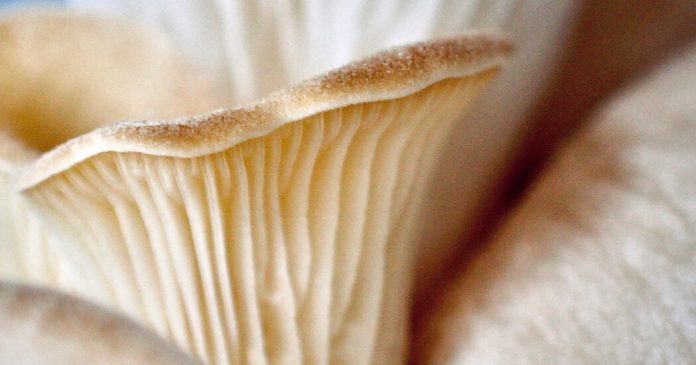Contemplate the oyster mushroom. It’s a gentle factor, a pert, typically creamy-colored whorl of fungus that goes properly with thyme sautéed in butter. However amongst scientists who examine mushrooms, it has earned a popularity for actions extra sinister than you’d count on from a fungus present in tremendous eating. The oyster mushroom is a carnivore.
The mushroom’s common weight loss plan of damp logs is low in nitrogen. To get that important factor, it feeds on microscopic nematodes, a sort of worm. When a worm makes the error of passing over the fungus, the oyster mushroom paralyzes and kills it, devouring the animal’s nitrogen-rich flesh with root-like tendrils known as hyphae.
Exterior the animal kingdom, Venus flytraps, pitcher vegetation and others are well-known for his or her macabre meal-making. However fungi, too, have an urge for food for flesh, and it’s not simply the oyster mushroom, though it’s the solely carnivorous fungus you’ll usually discover in your grocery retailer. Some fungi craft sticky nets laced with tempting scents to snare their prey. Others create lethal collars that constrict because the worm struggles, immobilizing the prey because the fungus’s hyphae, penetrate its physique. Some even launch tiny sickle-shape spores that, when swallowed by a nematode, wreak havoc from inside.
The situations all finish with the worm’s physique invaded by the threads of its hungry captor.
The oyster mushroom’s weapon of selection appears to be a toxin: Worms that contact the fungus are paralyzed, and their cells crumble as they succumb to the hyphae. In a paper revealed Wednesday within the journal Science Advances, researchers report that they’ve recognized the substance, which is contained in globes that they examine to lollipops. To the scientists’ shock, it’s a pretty widespread molecule, somewhat than an unique, extremely advanced substance. However to the hapless worms, it’s lethal.
Earlier than they knew the toxin’s identification, the researchers had been accustomed to its results, stated Yen-Ping Hsueh, a researcher on the Institute of Molecular Biology of the Academia Sinica in Taiwan, and an writer of the brand new paper. In 2020, the staff described how toxins get into worms’ our bodies by means of the delicate suggestions of the creature’s small sensing organs.
“They actually paralyze the worms inside a minute,” Dr. Hsueh stated. “It’s very dramatic.”
As soon as the toxin reaches the worm’s neurons and muscle cells, it destabilizes the traditional circulation of ions throughout the cells’ membranes, inflicting catastrophic failure.
For his or her newest paper, Dr. Hsueh and her colleagues used ultraviolet rays and a chemical that causes mutations on oyster mushrooms and appeared for people whose contact didn’t kill worms. They discovered that each one of those fungal mutants lacked small globes known as toxocysts that hold like fruit from the hyphae. These, they reasoned, should be the place the substance was saved.
However makes an attempt to pinpoint the toxin by harvesting the toxocysts from non-mutant mushrooms failed, and the researchers solely understood why after they discovered that bodily disturbing the globes made them innocent to worms. The substance should be unstable — floating away within the air as quickly as it’s launched.
Utilizing a machine to investigate the air above disturbed toxocysts revealed a single molecule: 3-octanone. That was stunning, Dr. Hsueh stated. 3-octanone is a comparatively commonplace substance made by vegetation and fungi. Additionally it is a standard ingredient in fragrances and flavors. However making use of the substance to worms made it clear 3-octanone had all of the ugly results of a brush with an oyster mushroom. That they had discovered their perpetrator.
Nematode worms have been recognized to destroy the roots of crops, and antiworm substances from nature have impressed medicine like ivermectin, the antiparasite medicine that made headlines throughout the peak of the pandemic. As a result of 3-octanone is unstable, it’s unlikely it could possibly be used as a pesticide towards worms — it could simply drift away. Moreover, the oyster mushroom solely goes to the difficulty to make toxocysts when it’s in a nitrogen-poor surroundings. So oyster mushrooms seemingly couldn’t function a type of pure pesticide alongside crops slathered with nitrogen-rich fertilizers.
However maybe, Dr. Hsueh stated, understanding how the oyster mushroom got here to make use of this substance as a toxin and what triggers the creation of toxocysts may open the door to a brand new type of pest management. If oyster mushrooms could possibly be made to arm themselves, even within the richness of a fertilized discipline, we’d sometime see their skills for destruction deployed on our behalf — and never simply within the service of creating themselves plumper and tastier for our plates.


